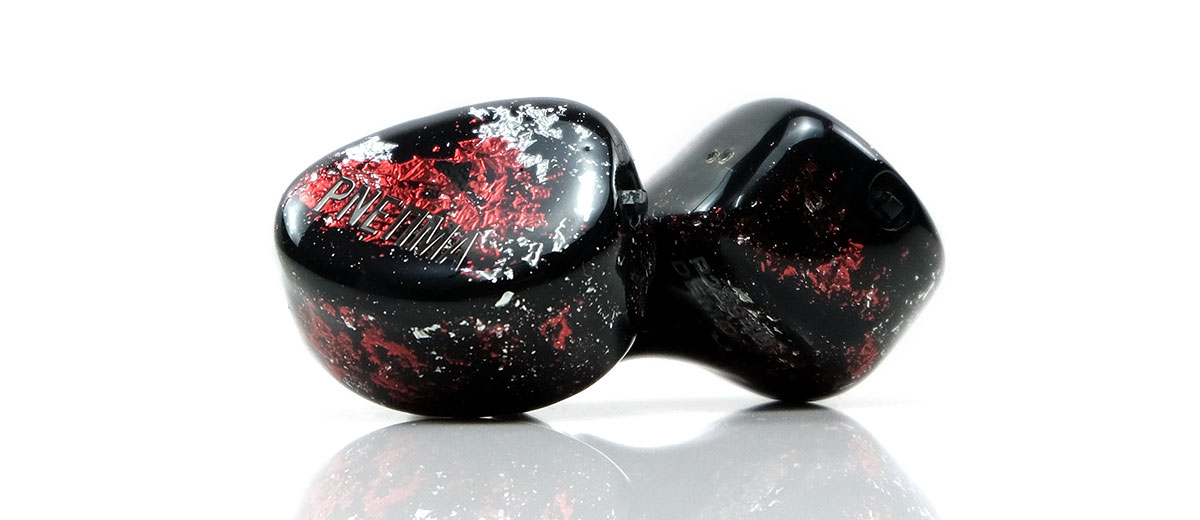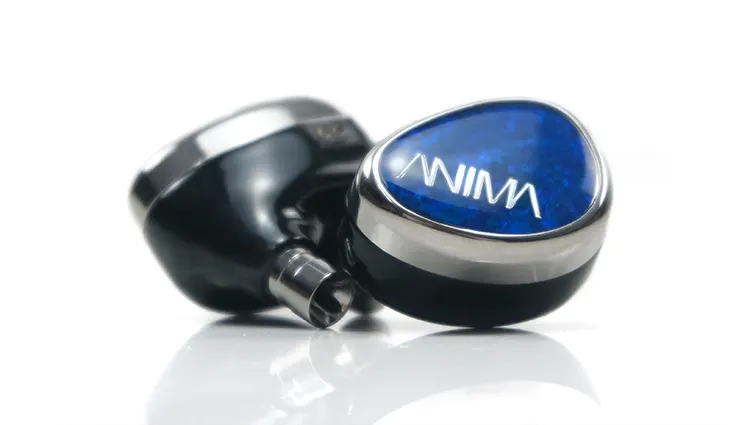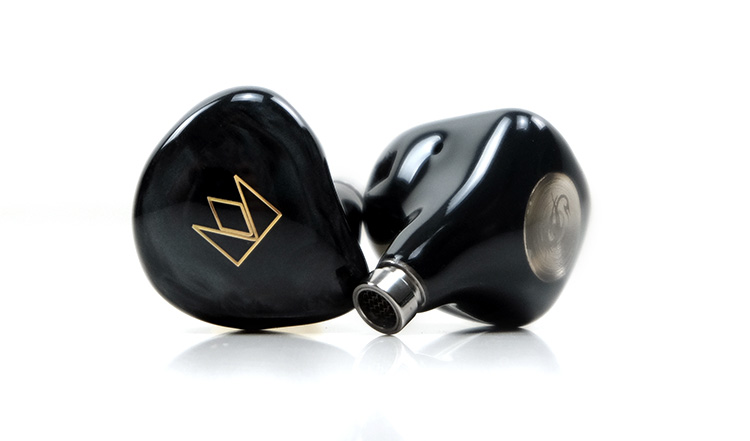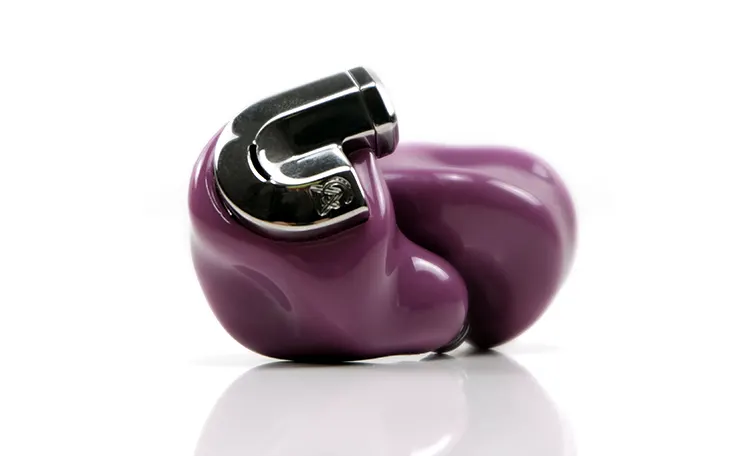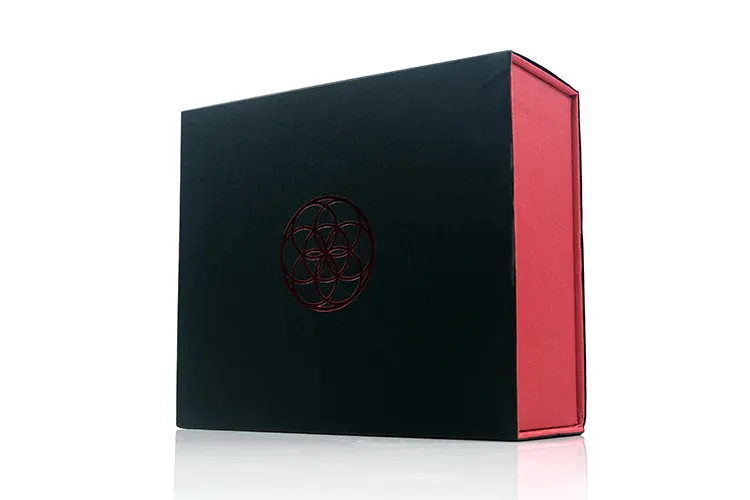Selected Comparisons
The following comparisons to the Lime Ears PNEUMA V2 were completed using a mix of the Chord Electronics Mojo 2 with the ddHiFi DJ44MOJO 4.4mm ground pin adapter and the HiBy R8 II with the stock cable fitted using a 4.4mm TermX module.
Lime Ears ANIMA V2
The recently reviewed Lime Ears ANIMA V2 is a second-generation flagship hybrid monitor released simultaneously with the PNEUMA V2.
Technical
The flagship ANIMA V2 is also a hybrid dynamic and BA driver IEM in universal and custom formats.
You get the same 7mm titanium diaphragm dynamic driver for the sub-bass frequencies combined with a dual BA setup for the lows though there is no mention of BAM technology in the ANIMA V2 literature.
The BA configuration differs. The ANIMA V2 has a more complex dual BA from the mid to upper bass, two vented BAs for the mids, and 2 BAs for the highs up to 10k. For the ultra-highs, it uses dual Sonion super tweeters.
The PNEUMA V2 reduces the BA driver count down to 1 for the highs and 1 for the mids with no split for the ultra-highs. The lows remain unchanged with the dual BA and dynamic driver covering the sub-bass to upper-bass frequencies.
Both IEMs use the new Horncraft CNC-machined stainless steel spout, however, the ANIMA V2 lacks the SubWITCH dual tuning technology so its tuning is fixed.
Design
I honestly think both designs are equally as nice perhaps even a slight edge to to the PNEUMA V2 over the ANIMA V2 for the stronger main shell and faceplate integration giving it a consistent singular theme as opposed to the two-tone look of the ANIMA V2.
There will be those who disagree though. One is blue and one is red on a very crude level and there is often a strong bias for one or the other.
I think the Bello Opal blue plate of the ANIMA V2 is more opulent but I miss the complimentary blue flake tones of the ANIMA V1 shell that went along with it. That collage is pleasingly retained on the PNEUMA V2.
The smaller form factors are virtually identical so the fit is equally comfortable. I could not find much difference in their passive isolation capabilities with the stock tips so both are rated well above average for hybrid IEMs.
The ANIMA V2 stock cable is a higher quality large gauge 2-wire custom 21AWG Litz design consisting of pure copper, SPC, and pure silver. You cannot go wrong with pure copper for the PNEUMA V2’s stock cable but its gauge is fairly large also but it’s not going to have quite the sparkle of the ANIMA V2 alternative.
What I will say, however, is the introduction of TermX for the PNEUMA V2 makes it more useful for connectivity. I am surprised the ANIMA V2 cable does not have the same system since both cables are custom-made by Effect Audio.
Performance
I can tell the ANIMA V2 is technically superior. Its presentation offers more intricate imaging and layering creating a far more complex soundstage with better height and width than the PNEUMA V2. If you are after the best imaging experience the ANIMA V2 is the right choice.
However, the PENUMA V2 has a more inviting tonal coloration and at times I would argue it has a better balance. It is more intimate sounding primarily due to the significant drop from mid-bass down to the lower-mids, which is more exaggerated on the ANIMA V2.
The PNEUMA V2 has a stronger bass shelf and a softer drop which enhances any note fundamental and carries some warmth into the mids timbre in the process.
Baritone male vocals or any lower-pitching vocals have more presence, improved body, and a slightly softer attack and decay giving them a more pleasing tonal quality.
Despite the technical superiority and perhaps even a better exposition of dynamic range the dip in the ANIMA V2 upper bass leaves midrange notes a bit colder and thinner sounding.
There is some enhanced treble on the PNEUMA V2 compared to the ANIMA V2, especially when you switch to the SpinFit tips on the ANIMA V2. You can smoothen the PNEUMA V2 highs out in a similar manner but even so its upper mids and treble from 4-6k onwards is more forward sounding.
With the SubWITCH activated the bass on the PNEUMA V2 is huge and bloomy compared to the ANIMA V2’s tighter low-end. The ANIMA V2 sub-bass competes very well, with a stronger degree of separation that doesn’t bleed into the mids.
However, the PENUMA V2 switch makes a significant difference in weight that benefits sparse R’n’B mixes and some EDM where the ANIMA V2 is less effective.
Noble Audio Kublai Khan
The Noble Audio Kublai Khan second-generation universal IEM was released in late 2022, and our review came out shortly after in early 2023.
Technical
Like the PNEUMA V2, the Kublai Khan builds on an earlier model, the Khan.
Both are hybrids, though the Kublai Khan is technically a mix of 4 different drivers instead of two with a larger 10mm dynamic driver for superb bass and sub-bass, a bone conductor subwoofer, four Knowles BA drivers for mid-low and mid-highs, and a Piezo super tweeter.
The tweeters on both models are new though of a different type. The PNEUMA V2 uses a Sonion for the highs and Noble uses a new generation ceramic 10mm Piezoelectric super tweeter for the highs to the ultra-highs.
The Kublai Khan’s bone conduction driver or subwoofer covers a low-frequency range, targeting the dynamic driver specifically to produce a more tactile bass response.
There is no dual tuning SubWITCH type of dual tuning mechanism on the Kublai Khan. Any tuning tweaking will be done via classic cable and tip-rolling methods.
Neither of these IEMs is listed with any benchmark data save for Noble starting that it is under 30Ω and easy enough to drive from portable sources. What I can tell you is that the Kublai Khan is slightly more sensitive than the PNEUMA V2 using a balanced output from the HiBy R8 II.
Design
Noble likes their IEMs to the larger side, at least for nozzle length with the Kublai Khan being no exception. The PNEUMA is not a tiny IEM but it looks a lot more compact with a shorter spout than the Noble design.
I have never had an issue with Noble IEM fitting because of that long spout which allows for a deep penetration using the tips to give it a very competitive deal for a hybrid IEM.
With the stock foam tips, it’s on par for passive isolation performance with the PNEUMA V2 but it sticks out a lot more from your ear than the Lime Ears design.
Aesthetically, the PENUMA V2 has a lot more going on with its Scarlet Silverstream red and silver theme. The Kublai Khan design is tastefully done with a shimmery dragon motif on top of a subtle charcoal blue galaxy swirl-infused faceplate with a curvy monotone shell.
It doesn’t stand out as much as the PNEUMA V2 design but aesthetics is a personal thing so I can appreciate some will prefer the toned-down Kublai Khan looks over the bright pop of the PNEUMA V2 visuals.
The custom EA cable with the TermX modular plug system feels more modern and functionally valuable compared to Noble’s Premium 8-core OCC cable.
The Noble stock cable is a nice design and technically easier to manage even if slightly heavier. However, you only have one plug option which might seem limiting compared to the TermX system on the PNEUMA V2.
Performance
There are times in this comparison I felt the Kublai Khan was the right choice then at other times I felt the PNEUMA V2 was a more enjoyable experience.
The Khan has a neutral tonality with a nice Harman quality to its bass shelf that is not overly done. However, if you want blood and thunder and more warmth in your recordings, the PNEUMA V2 is the better choice.
The deciding factor here seems to be more on the highs than the lows with some stark differences between the two that affect the midrange timbre.
The Kublai Khan highs are quite pushed and more aggressive sounding, even though I find the PNEUMA V2 highs to be relatively forward to begin with.
The Khan’s 8-10k range sounds more dominant and with a different driver in there for the highs the timbre is quite different sounding right down into the upper mids and for some vocal timbre. Combine that with a neutral mid-bass to lower-midrange tuning and the tone is much cleaner and slightly drier sounding.
The PNEUMA V2 has a more typical BA tone which is more forgiving, with less harmonic dissonance from the highs and only the odd bit of sibilance. With its stronger and longer bass shelf, the PNEUMA V2 sounds more euphonic and smoother through the mids.
However, clarity is a strength of the Kublai Khan tuning, at least when concerned with lower-pitched vocal performances and when the treble is not in overdrive.
It delivers excellent midrange clarity with a slightly lifted but otherwise very linear midrange FR. The bloom from the PNEUMA V2 lows can comparatively veil some vocal performances when compared side by side giving it a more distant less distinct quality.
Campfire Audio Bonneville
The Campfire Audio Bonneville is the flagship offering from the company’s recently released Chromatics Series of IEMs and one we reviewed earlier this year.
Technical
The Bonneville is a hybrid dynamic and BA driver, much like the PNEUMA V2. The precise configuration is a dual-magnetic 10mm for the lows, a single Knowles’ RLQ dual-diaphragm armature BA for the mids, and a dual BA for the highs.
There is no mixing of the dynamic and BA for the lows in a similar fashion as the PNEUMA V2 though Bonneville does offer more BA ‘range’ for the highs.
Campfire does have measurements but in a non-standardized format meaning the Bonneville needs 14.59 mVrms to reach 94 dB @ 1 kHz for SPL and has an impedance rating of 29Ω @ 1 kHz.
The PNEUMA V2 has nothing at all so subjectively, the Bonneville does seem a lot more sensitive than the CA model for volume matching from DAPs and dongles.
There is no SubWITCH type dual tuning system on the Bonneville, what you hear is what you get with a single stock tuning and tweaks via traditional tip or cable rolling.
Design
Placed beside the PNEUMA V2, the Bonneville looks huge but in defense of CA’s design approach, these shells are quasi-custom designed, meaning there is less nozzle dependence and more of a tighter concha fit so the spread on the concha basin has to be bigger to achieve that.
The comfort of the Bonneville is excellent but the passive isolation with the stock silicone tips is just average compared to the better isolation performance of the PNEUMA V2.
You can improve the Bonneville isolation performance with the stock foam tips but I find the wide-bore silicone tips to sound superior.
The aesthetics are both standouts for me in different ways. They are strong color choices with the monotone purple and silver chrome plates of the Bonneville creating a very unique visual experience. The fact the cables come with matching purple barrels and splitters only adds to the cool vibes of the Bonneville.
The Bonneville uses MMCX connectors, and they are good ones also but the different pricing structures for the Time Series cables depending on the types of plugs you want play into the hands of the PNEUMA V2 with its module TermX system.
The Bonneville comes in Essential or the Deluxe Editions meaning just one cable choice with the Essential or pay more for 3 cables with SE, 2.5mm, and 4.4mm included for the Deluxe Edition.
I would have preferred if Campfire went down the same route as Lime Ears and offered one cable with 3 modular plugs rather than 3 separate cables.
Performance
It is amazing how much your impression of an IEM’s sound signature can change rapidly with just a few dB of additional lift in the upper mids.
Both of these IEMs aim for roughly the same type of listener; someone who enjoys a heavy bass, and a colored and smooth sounding timbre for enjoyable non-reference listening.
Where their tuning deviates markedly from each other is in the 2-4k range where the Bonneville is quite subdued and the PNEUMA V2 is bursting with life.
That changes their entire presentation. Granted the PNEUMA V2 also has more energy up to 6k which brings in a stronger treble influence but the net effect is a more vibrant set of mids, stronger vocal presence with a more ‘filled-in’ quality in general.
The Bonneville sounds very relaxed in this region, drawing most of its harmonic balance from the lows and sounding very smooth, almost to a fault. Vocals can fall behind that mountain of bass.
That can be true of the PNEUMA V2 to a certain extent with the SubWITCH system turned on but the upper-mids lift keeps everything more or less in check with the best balance when the system is turned off.
Both have long bass shelves with slow dives into the lower mids and a bit of warmth coming up from the lows into the midrange. They can go quite deep with a bit of bloom when the song demands it.
Here again, the PNEUMA V2’s stronger treble lends a bit of necessary harmonic balance on the lower-register notes. Just enough for instruments to have a bit more crispness and incisiveness in their attack, perhaps aided by a slightly more open soundstage.
My Verdict
Like the original, the Lime Ears PNEUMA V2 continues to be the company’s dark horse IEM in its high-end lineup.
It’s a boisterous fun-sounding monitor with a low-end emphasis, sparkling highs, and a surprisingly open soundstage. Turning the SubWITCH on doubles down on the lows, going some way to satisfying a lot of bassheads.
It is a good-looking and comfortable IEM, with a useful modular cable system. However, like its bigger sibling (ANIMA V2) it’s a bit short on tips selection compared to the original. I would have liked to have seen SpinFits in there which are smoother sounding than the stock tips.
Overall, this is a good improvement on the 2020 original PNEUMA, and well worth a demo if you get a chance because it does outperform some lofty competition at this price point.
Lime Ears PNEUMA V2 Technical Specifications
- Five drivers, hybrid construction, four-way crossover:
- One 7mm Titanium-Diaphragm Dynamic Driver for infra-sub frequencies
- Two BA for low frequencies
- One BA for midrange
- One BA for high frequencies

